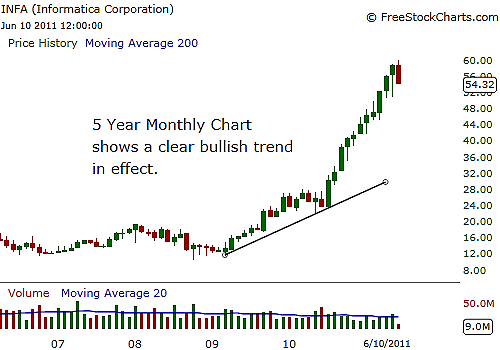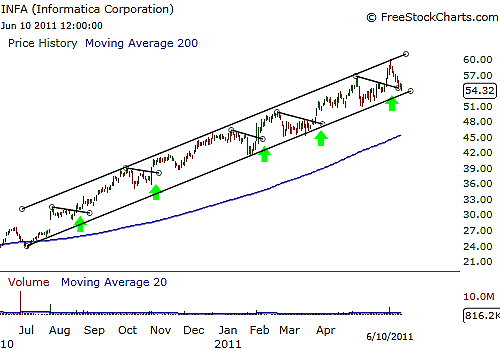
HOT TOPICS LIST
- MACD
- Fibonacci
- RSI
- Gann
- ADXR
- Stochastics
- Volume
- Triangles
- Futures
- Cycles
- Volatility
- ZIGZAG
- MESA
- Retracement
- Aroon
INDICATORS LIST
LIST OF TOPICS
PRINT THIS ARTICLE
by Billy Williams
Trend trading can result in large profits, but most traders still get it wrong and lose money. These three tips can help you stay on the winning side of this method.
Position: Hold
Billy Williams
Billy Williams has been trading the markets for 27 years, specializing in momentum trading with stocks and options.
PRINT THIS ARTICLE
TECHNICAL ANALYSIS
Three Critical Success Factors For Trend Trading
06/15/11 01:41:11 PMby Billy Williams
Trend trading can result in large profits, but most traders still get it wrong and lose money. These three tips can help you stay on the winning side of this method.
Position: Hold
| Trend trading is universally known as one of the most successful methods of trading because of one reason: It works. It is to this method that trading firms worth billions of dollars should give credit for creating entire industries on Wall Street including legendary traders, and countless others have all given credit to this concept as a cornerstone to their success. Trend trading is incredibly effective because it is a series of movements within a stock or market in a given direction that offers the intelligent speculator the opportunity to exploit that price movement for superior gains. However, while trend trading is possibly one of the most effective trading styles, if not the most effective style, most traders don't understand the dynamics that make up successful trend trades and lose money hand over fist. See Figure 1. |

|
| FIGURE 1: INFA. INFA on the long-term time frame shows that it is in a clear bullish trend that you want to be sure that you trade in the direction of. |
| Graphic provided by: www.freestockcharts.com. |
| |
| While there may be many reasons for an experienced trader to undergo a period of drawdown, it can also be reasoned that the lack of understanding of the essential fundamentals that act as the foundation for trading trends can also be the culprit for crippling losses. In order for you to benefit from the winning aspects of this trading method while avoiding the disastrous consequences of being ignorant of them, it is absolutely vital that you understand three key concepts of trend trading. The first concept is the "expansion and contraction concept," which states that the market's price action is primarily in one of two states depending on the time frame you are observing -- expansion or contraction. When the market is expanding, it is moving in force in a dominant direction with the force of the move dependent on price volume. Price volume reveals whether buyers or sellers have control of price. See Figure 2. |

|
| FIGURE 2: INFA. Dropping down to the one-year daily chart, you can see that INFA has formed a price channel and setup entries as the shorter-term time frame's trendline is broken as price action climbs higher in the direction of the dominant trend. |
| Graphic provided by: www.freestockcharts.com. |
| |
| When the market is in a period of contraction, neither buyers nor sellers have enough control of price to force into any given direction, dependent on the time frame you are observing. Price contraction is where trading ranges and chart patterns form before either the bulls or bears gain the upper hand, with price action following suit. This leads to the second concept of "higher highs, higher lows/lower lows, lower highs," which details the movement of price once it emerges from a period of price contraction to expansion. In a bullish trend, price will form a series of higher highs and higher lows, while in a bearish trend, price will move from a period of higher lows to higher highs. These wavelike price movements show the stairstep direction price takes once it is in a trend. |
| If price violates this pattern of movement, then a price reversal can occur and change the direction of the dominant trend in place. Finally, Dow theory states that there is the "concept of three trends" that you as a trader must become familiar with and be able to identify. They are the long-term trend, the intermediate-term trend, and the short-term trend. The long-term trend forms from a time period of months to years, the intermediate-term trend forms from a time period of weeks up to a year, and the short-term trend forms from a time period of few minutes to a week. It is important to know what each of the three trends are in a given market or stock because knowing will help you attain superior entries into a position as well as stay on the right side of the dominant trend in play. |
| To stay on the right side of the trend, make sure that you are trading in the direction of the primary trend on the larger time frame one time period up from where you currently are trading. For example, if you are trading a stock on an intermediate-time frame, then you want to look at the chart of a longer term time frame to make sure that you are in sync with its direction. The direction of the larger time frame has precedence over the small time frame's direction and can override it easily, resulting in needless losses. To make superior entries, you want to drop down one time frame from where you are trading in order to find a price reaction at the smaller level to help you gain a competitive advantage. If you're trading on the intermediate time frame as a stock swing trader using the weekly or daily chart, drop down to the daily chart or hourly chart to time your entry with greater precision. The mastery of these fundamental approaches leads to a deep understanding of these basic steps at a seminal level and can lead to successful trading. While it is easy to get distracted with the latest trading systems, the fact is that real day-to-day trading can be achieved along the path of tireless pursuit in the mastery of key concepts, particularly like the ones just detailed. |
Billy Williams has been trading the markets for 27 years, specializing in momentum trading with stocks and options.
| Company: | StockOptionSystem.com |
| E-mail address: | stockoptionsystem.com@gmail.com |
Traders' Resource Links | |
| StockOptionSystem.com has not added any product or service information to TRADERS' RESOURCE. | |
Click here for more information about our publications!
Comments

|

Request Information From Our Sponsors
- StockCharts.com, Inc.
- Candle Patterns
- Candlestick Charting Explained
- Intermarket Technical Analysis
- John Murphy on Chart Analysis
- John Murphy's Chart Pattern Recognition
- John Murphy's Market Message
- MurphyExplainsMarketAnalysis-Intermarket Analysis
- MurphyExplainsMarketAnalysis-Visual Analysis
- StockCharts.com
- Technical Analysis of the Financial Markets
- The Visual Investor
- VectorVest, Inc.
- Executive Premier Workshop
- One-Day Options Course
- OptionsPro
- Retirement Income Workshop
- Sure-Fire Trading Systems (VectorVest, Inc.)
- Trading as a Business Workshop
- VectorVest 7 EOD
- VectorVest 7 RealTime/IntraDay
- VectorVest AutoTester
- VectorVest Educational Services
- VectorVest OnLine
- VectorVest Options Analyzer
- VectorVest ProGraphics v6.0
- VectorVest ProTrader 7
- VectorVest RealTime Derby Tool
- VectorVest Simulator
- VectorVest Variator
- VectorVest Watchdog
